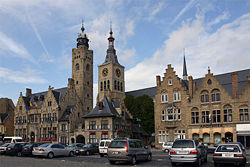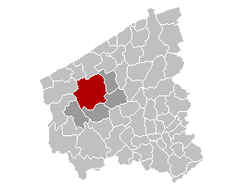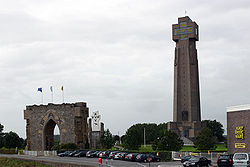- Diksmuide
-
Diksmuide Town Hall and St Nicholas Church 
Flag
Coat of armsLocation in Belgium Coordinates: 51°02′N 02°52′E / 51.033°N 2.867°E Country Belgium Region Flemish Region Community Flemish Community Province West Flanders Arrondissement Diksmuide Government - Mayor Lies Laridon (CD&V) - Governing party/ies CD&V, SP.A-Open Area - Total 149.40 km2 (57.7 sq mi) Population (1 January 2010)[1] - Total 16,275 - Density 108.9/km2 (282.1/sq mi) Postal codes 8600 Area codes 051 Website www.diksmuide.be Diksmuide (Dutch pronunciation: [ˌdɪks.ˈmœy̯.də]) (French: Dixmude) is a Belgian city and municipality in the Flemish province of West Flanders. The municipality comprises the city of Diksmuide proper and the former communes of Beerst, Esen, Kaaskerke, Keiem, Lampernisse, Leke, Nieuwkapelle, Oostkerke, Oudekapelle, Pervijze, Sint-Jacobs-Kapelle, Stuivekenskerke, Vladslo and Woumen.
Most of the area west of the city is a polder riddled with drainage trenches. The major economical assets of the region are agriculture and farming, producing the famous butter of Diksmuide.
Contents
History
Medieval origins
The 9th-century, Frankish settlement of Dicasmutha laid at the mouth of a stream near the Yser (IJzer in Dutch). By the 10th century, a chapel and market place were already established. The city’s charter was granted two centuries later and defensive walls built in 1270. The economy was already then based mainly on agriculture and farming, with milk products and linen driving the economy. From the 15th century to the French Revolution, Diksmuide was affected by the wars that confronted the Netherlands, France, Spain, and Austria, with a corresponding decline in activity. The 19th century was more peaceful and prosperous.
Marked by World War I
At the outset of World War I, German troops crossed the Belgian border near Arlon, then proceeded hurriedly towards the North Sea to secure the French ports of Calais and Dunkirk. The Battle of the IJzer started in October 1914. Thanks to the water the Belgians could stop the Germans. At the end of October the Belgians had opened the gates of the Yser river and flooded the area. As a result, the river became a front line throughout the First World War. The city was first attacked on October 16, 1914 and defended by Belgian and French troops, which marked the beginning of the Battle of the Yser. Colonel Alphonse Jacques de Dixmude led the troops that prevent Diksmuide from being taken by the German Army. By the time the fighting ended, the town had been reduced to rubble. It was, however, completely rebuilt in the 1920s.
Sights
- The belfry contains a 30-bell carillon and is one of the several Belfries of Belgium and France that are recognized by UNESCO as World Heritage Sites.
- The City Hall and neighbouring Saint Nicolas Church were completely rebuilt after World War I in the Gothic style of the 14th and 15th century.
- The “Trench of Death” (Dodengang in Dutch), about 1.5 km from the center of the city, preserves the trench setting where Belgian soldiers fought under the most perilous conditions until the final offensive of September 28, 1918.
- A peace monument, the IJzertoren, was built after the First World War in the twenties. This tower was destroyed by a bomb in 1946 because during the Second World War the IJzertower was the scene of ceremonies by Nazis and collaboration. The new tower was built in the 1950s. The tower houses a United-Nations-owned, World War I museum, where you can, among other things, experience the odour of mustard gas. The IJzertoren is also the scene of the yearly IJzerbedevaart, a celebration of peace and of Flemish political autonomy. During World War II, it was used for Nazi-inspired meetings. After the war it still had problems with neo-Nazis from all over Europe. However they were a minority, but the press emphasised this minority participation. But after long years the organisers succeeded in banning those radical neo-Nazis from the Yserpilgrimage. The more radical Flemish fraction now organizes the IJzerwake.
- Several military cemeteries are located around Diksmuide, including the Vladslo German war cemetery, which is now the resting place for more than 25,000 German soldiers. Famous sculpture of the 'Mourning parents' by Käthe Kollwitz.
The Pax is a four-star hotel, the Polderbloem on the main square a 2 star one.
Notable inhabitants
- Maria Doolaeghe, (1803-1884), writer
- Wim Vansevenant, Record three-time Tour de France Lanterne rouge winner
Twin cities
 Ellesmere, United Kingdom
Ellesmere, United Kingdom Ploemeur, France
Ploemeur, France Rottach-Egern, Germany
Rottach-Egern, Germany Finnentrop, Germany
Finnentrop, Germany
References
- ^ Population per municipality on 1 January 2010 (XLS; 221 KB)
External links
Bruges Beernem · Blankenberge · Bruges/Brugge · Damme · Jabbeke · Knokke-Heist · Oostkamp · Torhout · Zedelgem · Zuienkerke
Diksmuide Kortrijk Ostend Roeselare Tielt Veurne Ypres Heuvelland · Ieper/Ypres · Langemark-Poelkapelle · Mesen · Poperinge · Vleteren · Wervik · ZonnebekeCategories:- Populated places in Belgium
- Municipalities of West Flanders
- World Heritage Sites in Belgium
- Diksmuide
Wikimedia Foundation. 2010.




